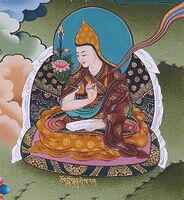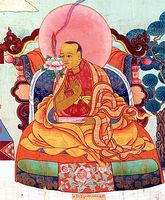Rngog blo ldan shes rab: Difference between revisions
Rngog blo ldan shes rab
No edit summary |
No edit summary |
||
| (38 intermediate revisions by 4 users not shown) | |||
| Line 1: | Line 1: | ||
{{Person | {{Person | ||
|MainNamePhon=Ngok Lotsāwa Loden Sherab | |||
|SortName=Ngok Lotsāwa | |||
|MainNameTib=རྔོག་བློ་ལྡན་ཤེས་རབ་ | |||
|MainNameWylie=rngog blo ldan shes rab | |MainNameWylie=rngog blo ldan shes rab | ||
| | |PersonType=Authors of Tibetan Works; Classical Tibetan Authors; Lotsawas | ||
| | |images=File:Rngog blo ldan.jpg | ||
File:Ngok Lotsawa.jpg | |||
|YearBirth=1059 | |YearBirth=1059 | ||
|YearDeath=1109 | |YearDeath=1109 | ||
|BornIn=yar 'brog (lho ka) | |BornIn=yar 'brog (lho ka) | ||
|BdrcLink=https://www.tbrc.org/#!rid=P2551 | |BdrcLink=https://www.tbrc.org/#!rid=P2551 | ||
|BdrcPnum=2551 | |||
|TolLink=https://treasuryoflives.org/biographies/view/Ngok-Loden-Sherab/4261 | |TolLink=https://treasuryoflives.org/biographies/view/Ngok-Loden-Sherab/4261 | ||
|tolExcerpt=Ngok Lotsāwa was nephew of Ngok Lekpai Sherab, the founder of Sangpu Neutok, and not only carried on the teaching activities of his uncle but raised the fame and prestige of Sangpu to new heights. He was important not only to his own Kadam lineage, but to the development of Tibetan education in general. Ngok Lotsāwa, working with the Kashmiri paṇḍita Sajjana, produced the sole-surviving translation of the Ratnagotravibhāga, the central text of buddha-nature theory in Tibet. His commentary on the text is said to have initiated the "analytical" exegetical tradition. | |||
|HasDrlPage=Yes | |HasDrlPage=Yes | ||
|HasLibPage= | |HasLibPage=Yes | ||
|HasRtzPage=No | |HasRtzPage=No | ||
|HasDnzPage=No | |HasDnzPage=No | ||
|HasBnwPage=Yes | |||
|AltNamesWylie=rngog lo tsA ba; lo chen blo ldan shes rab; blo ldan shes rab; | |||
|AltNamesTib=རྔོག་ལོ་ཙཱ་བ་; ལོ་ཆེན་བློ་ལྡན་ཤེས་རབ་ | |||
|AltNamesOther=Ngok Lotsāwa; Ngok Loden Sherab; Lochen Loden Sherab; Loden Sherab | |||
|TibDateGender=Female | |||
|TibDateElement=Earth | |||
|TibDateAnimal=Pig | |||
|TibDateRabjung=1 | |||
|ReligiousAffiliation=Kadam | |||
|PersonalAffiliation=rngog legs pa'i shes rab | |||
|StudentOf=Rin chen bzang po; Sajjana; Parahitabhadra | |||
|TeacherOf=shes rab 'bar; gro lung pa blo gros 'byung gnas; Zhang tshe spong chos kyi bla ma; rin chen nam mkha' rdo rje; rin chen grags | |||
|PosBuNayDefProv=Definitive | |||
|BuNayDefProvComplex=No | |||
|PosBuNayDefProvNotes=* "He is also said to have held that among the five Teachings of Maitreya only the ''Ratnagotravibhāga'' is of definitive meaning (''nītārtha'')." [[Ruegg, D.]], ''[[Studies in Indian and Tibetan Madhyamaka Thought Part 1]]'', p. 30. | |||
* "rNgog considers the RGV to be a Madhyamaka work, and hence its teaching to be definitive. His position is made clear in the introductory passage of the ''rGyud bla don bsdus'', where RGV is identified as a treatise that explains sūtras of definitive meaning (''nītārtha''), whereas the other four treatises of Maitreya (i.e. ''Abhisamayālaṃkāra'', ''Mahāyānasūtrālaṃkāra'', ''Madhyāntavibhāga'', and ''Dharmadharmatāvibhāga'') are listed as treatises that explain sutras of provisional meaning (''neyārtha'')." [[Kano, K.]], ''[[Buddha-Nature and Emptiness]]'', p. 249. | |||
|PosAllBuddha=Qualified Yes | |||
|PosAllBuddhaNote="...both Ngok and Chapa argue that sentient beings do not have tathāgata-essence on the basis of the first reason because they do not have the purified enlightened body of a buddha, rather they have the potential to achieve an enlightened state. However, they agree that sentient beings have the tathāgata-essence from the perspective of the second reason, which is that such-ness is indivisible or nondual. As Ngok states, 'That both a tathāgata and ordinary beings have tathāgata-essence is actually the case.' The first reason is true only for enlightened beings, but only designated for ordinary beings; the second reason applies to both enlightened beings and sentient beings. Therefore, the two Kadam masters argue that sentient beings do not have the tathāgata-essence from the perspective of either the first reason of the resultant essence or the third reason of the causal essence. Rather it is the second reason that becomes the central point for establishing the link between enlightenment and sentient beings. It is the middle reason that shows that sentient beings and tathāgatas are the same in their ultimate nature. In other words, the only thing that sentient beings have in common with enlightened beings is the ultimate nature of their minds." | |||
|PosAllBuddhaMoreNotes=[[Wangchuk, Tsering]], ''[[The Uttaratantra in the Land of Snows]]'', pp. 17-18. | |||
|PosWheelTurn=Third Turning | |||
|BuNayWheelTurnComplex=No | |||
|PosYogaMadhya=Madhyamaka | |||
|BuNayYogaMadhyaComplex=No | |||
|PosYogaMadhyaNotes="rNgog considers the RGV to be a Madhyamaka work, and hence its teaching to be definitive. His position is made clear in the introductory passage of the ''rGyud bla don bsdus'', where RGV is identified as a treatise that explains sūtras of definitive meaning (''nītārtha''), whereas the other four treatises of Maitreya (i.e. ''Abhisamayālaṃkāra'', ''Mahāyānasūtrālaṃkāra'', ''Madhyāntavibhāga'', and ''Dharmadharmatāvibhāga'') are listed as treatises that explain sutras of provisional meaning (''neyārtha'')." [[Kano, K.]], ''[[Buddha-Nature and Emptiness]]'', p. 249. | |||
|BuNayZhenRangComplex=No | |||
|BuNayVehiclesComplex=No | |||
|PosAnalyticMedit=Analytic Tradition | |||
|BuNayAnalyticMeditComplex=No | |||
|PosAnalyticMeditNotes="These two traditions of rngog and btsan were respectively called the "analytical tradition" (''thos bsam gyi lugs'') and "meditative tradition" (''sgom lugs'')."[[Kano, K.]], ''[[Buddha-Nature and Emptiness]]'', p. 242. | |||
|PosEmptyLumin=Tathāgatagarbha as the Emptiness That is a Non-implicative Negation (without enlightened qualities) | |||
|BuNayEmptyLuminComplex=No | |||
|PosEmptyLuminNotes=* "As to the interpretation of Buddha-nature, on the other hand, Sajjana and rNgog hold different views, for Sajjana equates Buddha-nature with the luminous mind, which is not empty, while rNgog equates it with emptiness." [[Kano, K.]], ''[[Buddha-Nature and Emptiness]]'', p. 239. | |||
* According to Brunnhölzl, he also equates it with the ālaya-consciousness: "Moreover, Ngog equates “dhātu” not only with the tathāgata heart (as in RGVV) but also with the ālaya-consciousness (maybe influenced by the ''Laṅkāvatārasūtra''). Obviously, this creates a considerable tension with his definition of the tathāgata heart as emptiness, but he does not resolve it..." [[Brunnhölzl, K.]], ''[[When the Clouds Part]]'', p. 66. | |||
|IsInGyatsa=No | |IsInGyatsa=No | ||
|pagename=Rngog blo ldan shes rab | |||
|PosSvataPrasa=Svātantrika (རང་རྒྱུད་) | |||
|PosSvataPrasaNotes=* "A number of later Tibetan works, and several modern scholars as well, define his position as Svātantrika-Madhyamaka... We cannot yet be sure whether rNgog himself was conscious of this divide, even if later Tibetan traditions often presuppose rNgog's knowledge of it. Śākya-mchog-ldan, for instance, in assigning rNgog to a third position of Madhyamaka neither Svātantrika nor Prāsaṅgika, presumes that rNgog knew of both schools." [[Kano, K.]], ''[[Buddha-Nature and Emptiness]]'', p. 228. | |||
* "rNgog lo is known to have actively taught and commented on the “Three Svātantrika Treatises of Eastern India” (''rang rgyud shar gsum''), namely the ''Satyadvayavibhaṅga'' of Jñānagarbha, the ''Madhyamakālaṃkāra'' of Śāntarakṣita, and the ''Madhyamakāloka'' of Kamalaśīla, which formed the textual foundation of the Svātantrika Yogācāra-Madhyamaka synthesis, among whose proponents rNgog lo may be counted. [[Kramer, R.]], ''[[The Great Tibetan Translator]]'', p.10. | |||
* "rNgog's strategy here is to appeal to the destinction between the Two Truths..." [[Kano, K.]], ''[[Buddha-Nature and Emptiness]]'', p. 271. | |||
|PosVajrapada=First four are causes of the later three; also, the three jewels are the results of the latter four (which are substantive causes and attendant conditions). [[Kano, K.]], ''[[Buddha-Nature and Emptiness]]'', p. 252. | |||
}} | }} | ||
Latest revision as of 14:42, 9 October 2023
| PersonType | Category:Authors of Tibetan Works Category:Classical Tibetan Authors Category:Lotsawas |
|---|---|
| MainNamePhon | Ngok Lotsāwa Loden Sherab |
| MainNameTib | རྔོག་བློ་ལྡན་ཤེས་རབ་ |
| MainNameWylie | rngog blo ldan shes rab |
| SortName | Ngok Lotsāwa |
| AltNamesTib | རྔོག་ལོ་ཙཱ་བ་ · ལོ་ཆེན་བློ་ལྡན་ཤེས་རབ་ |
| AltNamesWylie | rngog lo tsA ba · lo chen blo ldan shes rab · blo ldan shes rab |
| AltNamesOther | Ngok Lotsāwa · Ngok Loden Sherab · Lochen Loden Sherab · Loden Sherab |
| YearBirth | 1059 |
| YearDeath | 1109 |
| BornIn | yar 'brog (lho ka) |
| TibDateGender | Female |
| TibDateElement | Earth |
| TibDateAnimal | Pig |
| TibDateRabjung | 1 |
| ReligiousAffiliation | Kadam |
| PersonalAffiliation | rngog legs pa'i shes rab |
| StudentOf | Rinchen Zangpo · Sajjana · Parahitabhadra |
| TeacherOf | shes rab 'bar · gro lung pa blo gros 'byung gnas · Zhang Tsepong Chökyi Lama · rin chen nam mkha' rdo rje · rin chen grags |
| BDRC | https://www.tbrc.org/#!rid=P2551 |
| Treasury of Lives | https://treasuryoflives.org/biographies/view/Ngok-Loden-Sherab/4261 |
| IsInGyatsa | No |
| PosBuNayDefProv | Definitive |
| PosBuNayDefProvNotes |
|
| PosAllBuddha | Qualified Yes |
| PosAllBuddhaNote | "...both Ngok and Chapa argue that sentient beings do not have tathāgata-essence on the basis of the first reason because they do not have the purified enlightened body of a buddha, rather they have the potential to achieve an enlightened state. However, they agree that sentient beings have the tathāgata-essence from the perspective of the second reason, which is that such-ness is indivisible or nondual. As Ngok states, 'That both a tathāgata and ordinary beings have tathāgata-essence is actually the case.' The first reason is true only for enlightened beings, but only designated for ordinary beings; the second reason applies to both enlightened beings and sentient beings. Therefore, the two Kadam masters argue that sentient beings do not have the tathāgata-essence from the perspective of either the first reason of the resultant essence or the third reason of the causal essence. Rather it is the second reason that becomes the central point for establishing the link between enlightenment and sentient beings. It is the middle reason that shows that sentient beings and tathāgatas are the same in their ultimate nature. In other words, the only thing that sentient beings have in common with enlightened beings is the ultimate nature of their minds." |
| PosAllBuddhaMoreNotes | Wangchuk, Tsering, The Uttaratantra in the Land of Snows, pp. 17-18. |
| PosWheelTurn | Third Turning |
| PosYogaMadhya | Madhyamaka |
| PosYogaMadhyaNotes | "rNgog considers the RGV to be a Madhyamaka work, and hence its teaching to be definitive. His position is made clear in the introductory passage of the rGyud bla don bsdus, where RGV is identified as a treatise that explains sūtras of definitive meaning (nītārtha), whereas the other four treatises of Maitreya (i.e. Abhisamayālaṃkāra, Mahāyānasūtrālaṃkāra, Madhyāntavibhāga, and Dharmadharmatāvibhāga) are listed as treatises that explain sutras of provisional meaning (neyārtha)." Kano, K., Buddha-Nature and Emptiness, p. 249. |
| PosAnalyticMedit | Analytic Tradition |
| PosAnalyticMeditNotes | "These two traditions of rngog and btsan were respectively called the "analytical tradition" (thos bsam gyi lugs) and "meditative tradition" (sgom lugs)."Kano, K., Buddha-Nature and Emptiness, p. 242. |
| PosEmptyLumin | Tathāgatagarbha as the Emptiness That is a Non-implicative Negation (without enlightened qualities) |
| PosEmptyLuminNotes |
|
| PosSvataPrasa | Svātantrika (རང་རྒྱུད་) |
| PosSvataPrasaNotes |
|
| PosVajrapada | First four are causes of the later three; also, the three jewels are the results of the latter four (which are substantive causes and attendant conditions). Kano, K., Buddha-Nature and Emptiness, p. 252. |
| Other wikis |
If the page does not yet exist on the remote wiki, you can paste the tag |

